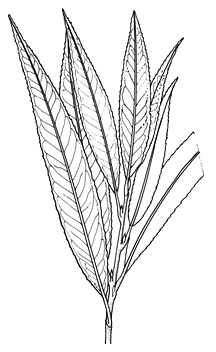Salix x sepulcralis Simonk. APNI* 
Description: Weeping tree to 18 m high, trunks 1-several; crown wider than high; bark grey-brown to dark brown, moderately fissured; outer branches, twigs and shoots weeping, only shoots hanging vertically; twigs not fragile; buds brown.
Leaves narrow-lanceolate, 7–18.5 cm long, 8–29 mm wide, dark green above, glaucous or glaucescent below, margin glandular-serrate; petioles usually with 1–several dark brown sessile glands; stipules if present also with scattered sessile glands.
Catkins male or female, or with male and female flowers, 1.5–5 cm long. Stamens 2.
Capsules 4–6 mm long.
Distribution and occurrence: widely planted and commonly naturalised, a garden hybrid originating in Europe.
NSW subdivisions: *NC, *CC, *CT, *NWS, *CWS
Other Australian states: *Vic.
Formerly identified with Salix babylonica but now considered a hybrid taxon Salix alba var. vitellina x babylonica), or hybrid involving Salix alba var. alba and S. babylonica.
Text by S.W.L. Jacobs & L. Murray (2000)
Taxon concept: Flora of NSW 1 Suppl. (2000)
| | Key to the varieties | |
| 1 | Twigs brown-green to olive-green; plants apparently mostly female. | var. sepulcralis |
| Twigs golden to greenish-yellow; distribution of sexes ± equal, plants commonly with male and female flowers | var. chrysocoma |
APNI* Provides a link to the Australian Plant Name Index (hosted by the Australian National Botanic Gardens) for comprehensive bibliographic data
***The AVH map option provides a detailed interactive Australia wide distribution map drawn from collections held by all major Australian herbaria participating in the Australian Virtual Herbarium project.
|


